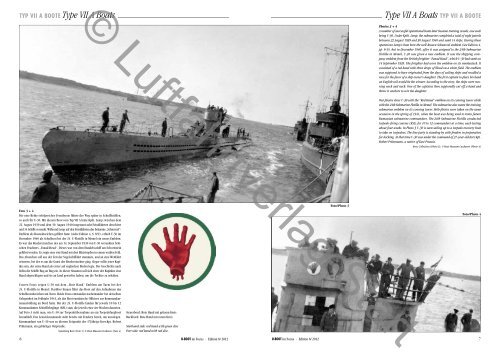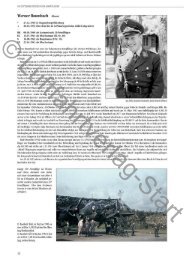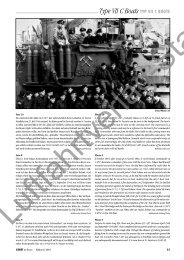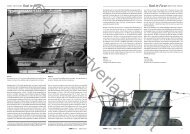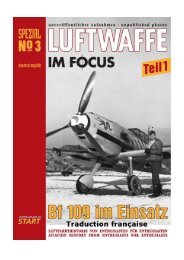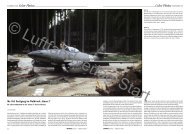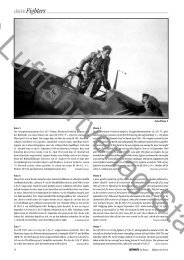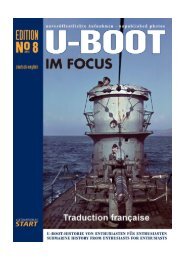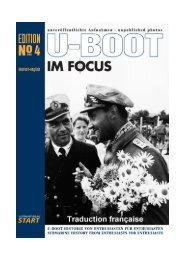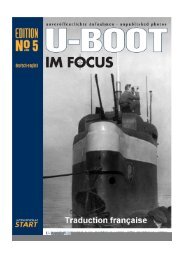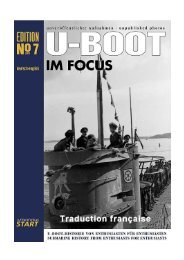Type VII A Boats TYP VII A BOOTE
Type VII A Boats TYP VII A BOOTE
Type VII A Boats TYP VII A BOOTE
Create successful ePaper yourself
Turn your PDF publications into a flip-book with our unique Google optimized e-Paper software.
<strong>TYP</strong> <strong>VII</strong> A <strong>BOOTE</strong> <strong>Type</strong> <strong>VII</strong> A <strong>Boats</strong><br />
Foto 3 + 4<br />
Für eine Reihe erfolgreicher Frontboote führte der Weg später in Schulflottillen,<br />
so auch für U-30. Mit diesem Boot vom Typ <strong>VII</strong> A hatte Kptlt. Lemp zwischen dem<br />
22. August 1939 und dem 30. August 1940 insgesamt acht Feindfahrten absolviert<br />
und 14 Schiffe versenkt. Während Lemp auf den Feindfahrten das bekannte „Schnurzel“-<br />
Emblem als Bootsabzeichen geführt hatte (siehe Edition 4, S. 8/9), erhielt U-30 im<br />
Dezember 1940 als Schulboot bei der 24. U-Flottille in Memel ein neues Emblem.<br />
Es war das Reedereizeichen des am 14. September 1939 von U-30 versenkten britischen<br />
Frachters „Fanad Head“. Dieses war von dem Handelsschiff am Schornstein<br />
geführt worden. Es zeigte eine rote Hand mit drei Blutstropfen in einem weißen Feld.<br />
Das Abzeichen soll aus der Zeit der Segelschiffahrt stammen, und an eine Wettfahrt<br />
er innern, bei der es um die Gunst der Reederstochter ging. Sieger sollte jener Kapitän<br />
sein, der seine Hand als erster auf englischen Boden legte. Der Geschichte nach<br />
liefen die Schiffe Bug an Bug ein. In dieser Situation soll sich einer der Kapitäne eine<br />
Hand abgeschlagen und sie an Land geworfen haben, um die Tochter zu erhalten.<br />
Unsere Fotos zeigen U-30 mit dem „Rote Hand“ Emblem am Turm bei der<br />
24. U-Flottille in Memel. Darüber hinaus führt das Boot auf den Aufnahmen das<br />
Schulbootabzeichen am Turm. Beide Fotos entstanden nacheinander bei derselben<br />
Gelegenheit im Frühjahr 1941, als das Boot rumänische Offiziere zur Kommandantenausbildung<br />
an Bord hatte. Bei der 24. U-Flottille fanden für jeweils 10 bis 12<br />
Kommandanten Schießlehrgänge (KSL) statt, die jeweils etwa vier Wochen dauerten.<br />
Auf Foto 3 sieht man, wie U-30 zur Torpedoübernahme an ein Torpedofangboot<br />
heranläuft. Das Leinenkommando steht bereits mit Fendern bereit, um anzulegen.<br />
Kommandant von U-30 war zu diesem Zeitpunkt der 37jährige Korv.Kpt. Robert<br />
Prützmann, ein gebürtiger Ostpreuße.<br />
Sammlung Renz (Foto 3), U-Boot Museum Cuxhaven (Foto 4)<br />
Steuerbord: Rote Hand mit grünem Kreis<br />
Backbord: Rote Hand mit rotem Kreis<br />
Starboard side: red hand with green disc<br />
Port side: red hand with red disc.<br />
<strong>Type</strong> <strong>VII</strong> A <strong>Boats</strong> <strong>TYP</strong> <strong>VII</strong> A <strong>BOOTE</strong><br />
6 U-BOOT im Focus · Edition 8/ 2012 U-BOOT im Focus · Edition 8/ 2012<br />
7<br />
Foto/Photo 3<br />
Photos 3 + 4<br />
A number of successful operational boats later became training vessels, one such<br />
being U-30. Under Kptlt. Lemp, the submarine completed a total of eight patrols<br />
between 22 August 1939 and 30 August 1940 and sank 14 ships. During these<br />
operations Lemp’s boat bore the well-known Schnurzel emblem (see Edition 4,<br />
pp. 8-9), but in December 1940, after it was assigned to the 24th Submarine<br />
Flotilla in Memel, U-30 was given a new emblem. It was the shipping company<br />
emblem from the British freighter “Fanad Head”, which U-30 had sunk on<br />
14 September 1939. The freighter had worn the emblem on its smokestack. It<br />
consisted of a red hand with three drops of blood on a white field. The emblem<br />
was supposed to have originated from the days of sailing ships and recalled a<br />
race for the favor of a ship owner’s daughter. The first captain to place his hand<br />
on English soil would be the winner. According to the story, the ships were running<br />
neck and neck. One of the captains then supposedly cut off a hand and<br />
threw it onshore to win the daughter.<br />
Our photos show U-30 with the “Red Hand” emblem on its conning tower while<br />
with the 24th Submarine Flotilla in Memel. The submarine also wears the training<br />
submarine emblem on its conning tower. Both photos were taken on the same<br />
occasion in the spring of 1941, when the boat was being used to train future<br />
Rumanian submarine commanders. The 24th Submarine Flotilla conducted<br />
torpedo-firing courses (KSL) for 10 to 12 commanders at a time, each lasting<br />
about four weeks. In Photo 3 U-30 is seen sailing up to a torpedo recovery boat<br />
to take on torpedoes. The line party is standing by with fenders in preparation<br />
for docking. At that time U-30 was under the command of 37-year-old Korv.Kpt.<br />
Robert Prützmann, a native of East Prussia.<br />
Renz Collection (Photo 3), U-Boat Museum Cuxhaven (Photo 4)<br />
Foto/Photo 4
TÜRME Conning Towers<br />
U-83 – mit Streifentarnung im Atlantik und Mittelmeer<br />
U-83 – Striped Camouflage in the Atlantic and Mediterranean<br />
von Axel Urbanke<br />
Als wir den Titel für die Edition 2 auswählten, verfügten wir lediglich über jenes<br />
einzelne Foto von U-83 mit der interessanten Streifentarnung. Die Aufnahme stammte<br />
aus dem Nachlaß des Kriegsberichters Garms und wurde im Herbst 1941 im Atlantik<br />
aufgenommen, wahrscheinlich während der 2. Feindfahrt. Darüber hinaus<br />
lag uns seinerzeit bereits eine Aufnahme aus La Spezia vor, die belegte, daß die<br />
Streifentarnung von U-83 in abgewandelter Form auch noch während dessen Mittelmeereinsatz<br />
geführt wurde. Eine genaue zeitliche Einordnung des Bildes fiel uns aber<br />
zunächst schwer, da das Boot La Spezia diverse Male anlief.<br />
Die in diesem Artikel nun veröffentlichen Fotos von U-83, die uns kürzlich zugingen,<br />
klären einiges auf. Sie wurden am 21. März 1942 bei der Rückkehr des Bootes von<br />
der 5. Feindfahrt in Salamis/Griechenland aufgenommen. Deutlich zu sehen ist die<br />
identische Streifentarnung, wie wir sie vom Titel von Edition 2 kennen. Es ist somit<br />
zweifelsfrei nachzuweisen, daß U-83 zumindest auf den Feindfahrten 2 bis 5 diese<br />
interessante Tarnung führte.<br />
When we selected the cover photo for Edition 2, we had just a single photo of U-83<br />
in its interesting striped camouflage scheme. The photo came from the estate<br />
of war reporter Garms and was taken in the Atlantic in autumn 1941, probably<br />
during the boat’s second patrol. At the time we also had a photo taken in<br />
La Spezia that proved that U-83 retained a modified form of its striped camouflage<br />
during its service in the Mediterranean. We initially found it difficult to<br />
date the photograph, because the boat sailed into La Spezia a number of times.<br />
We recently received the photos which accompany this article on U-83, and<br />
they clear up a number of things. The photos were taken in Salamis, Greece on<br />
21 March 1942 on the submarine’s return from its fifth patrol. In them the submarine<br />
is clearly wearing the same striped camouflage seen in the cover photo<br />
of Edition 2. We can thus state with certainty that U-83 wore this interesting<br />
camouflage scheme at least during the period encompassing its second to fifth<br />
patrols.<br />
14 U-BOOT im Focus · Edition 8/ 2012 U-BOOT im Focus · Edition 8/ 2012<br />
15<br />
Foto/Photo 12<br />
Wie konnten wir die Fotos nun zuordnen! Viele Fachleute werden sicherlich von<br />
den zwei Versenkungswimpeln am Turm irritiert sein, da U-83 auf der 5. Feindfahrt<br />
nachweislich nur eine Versenkung gelang. Lassen wir daher diese Unternehmung<br />
nochmals Revue passieren.<br />
Kptlt. Kraus ist beim Auslaufen zur 5. Feindfahrt am 10. März 1942 in Salamis alles<br />
andere als zufrieden. Im KTB hält er später fest: „Durch Krankheit und Abkommandierung<br />
lief ich mit rund 50% neuen Seeleuten aus. Es war mir nicht möglich,<br />
diese Leute während des Anmarsches ins Operationsgebiet noch auszubilden, da es<br />
praktisch keinen Anmarsch gibt im Mittelmeer, wie im Atlantik. Ausbildung am Pier<br />
im Stützpunkt genügt nicht. Es muß angestrebt werden, zu den Mittelmeerflottillen<br />
den besten und hochwertigsten Personalersatz zu kommandieren, da es eben ein<br />
langsames Einspielen und Einleben, wie im allgemeinen in den ersten 8-10 Tagen<br />
eines Atlantikunternehmens möglich ist, hier nicht gibt.“ Die Sätze machen deutlich,<br />
Conning Towers TÜRME<br />
Foto 12<br />
Salamis/Griechenland, 21. März 1942, 10.35 Uhr. U-83 kehrt von seiner 5. Feindfahrt<br />
zurück. Das Leinenkommando macht sich zum Anlegen bereit. Beachte die Segmenttarnung<br />
des Überwasserschiffs von U-83. Rechts im Bild der Flottilleningenieur der<br />
23. U-Flottille, Oblt.z.S. (Ing.) Erich Zürn, der am 23.4.1941 als LI von U-48 (Kptlt.<br />
Schultze) mit dem Ritterkreuz ausgezeichnet worden war.<br />
Sammlung Wihelmj<br />
Photo 12<br />
Salamis, Greece, 21 March 1942, 10:35. U-83 returns from its fifth patrol. The<br />
line party prepares for docking. Note the segment camouflage on U-83’s topdeck.<br />
On the right in the photo is the flotilla engineer of the 23rd Submarine<br />
Flotilla, Oblt.z.S. (Ing.) Erich Zürn. He had been awarded the Knight’s Cross on<br />
23 April 1941 while serving as leading engineer on U-48 (Kptlt. Schultze).<br />
Wilhelmj Collection<br />
Now we could classify the photos. Many experts will no doubt be irritated by<br />
the two sinking pennants on the conning tower, as U-83 is known to have sunk<br />
just one ship during its fifth patrol. Let us therefore review this operation once<br />
again.<br />
Kptlt. Kraus was anything but satisfied when he left Salamis to begin the submarine’s<br />
fifth patrol on 10 March 1942. He later wrote in the boat’s war diary:<br />
“Due to illness and transfers, I sailed with about 50% new seamen. I had no<br />
opportunity to train these people in transit to the area of operations, for in the<br />
Mediterranean there is almost no transit time as in the Atlantic. Training on the<br />
pier in the submarine base was not enough. An effort must be made to transfer<br />
the best and highest grade replacement personnel to the Mediterranean flotillas,<br />
for there simply isn’t time for the long settling-down and settling-in process<br />
that is usually possible during the first eight to ten days of an Atlantic patrol.”<br />
These sentences show that Kraus felt that putting to sea with new inexperienced<br />
men posed a great risk. But he had to make the best of the situation. Kraus was<br />
also unhappy because he had to cover the first stage of the voyage in the Gulf<br />
of Piraeus without an escort on account of a submarine warning. The escort<br />
had allegedly been diverted to hunt for the enemy submarine. When U-83 sailed<br />
through the area in question, however, there were no ships to be seen anywhere.<br />
“Given the submarine threat, the escort ship probably chose not to put to sea at<br />
all. I don’t see this as the job of a submarine escort”, he wrote in the war diary.<br />
In calm seas and good visibility, the U-boat headed south through the Aegean and<br />
past Crete. From that point on, numerous Allied aircraft were sighted patrolling<br />
the sea. Kraus had on board spare parts for U-559 (Kptlt. Heidtmann) and during<br />
the night 11-12 March he made contact with the boat to arrange a transfer.<br />
The two submarines were supposed to rendezvous in grid square 6711 at four<br />
in the morning, but U-559 did not show up. During the day contact was reestablished<br />
and that night the spare parts and mail were transferred in grid square<br />
5695. The entire process took twenty minutes. U-83 then set course for Point<br />
“Z” east of Tobruk to begin operations. The 13th of March was quiet except for<br />
a hydrophone homing, and at three in the morning, close to the coast near Ras<br />
Assaz, Kraus ordered a diesel test at high-speed cruise and maximum power. The<br />
dockyard in Salamis had refused to accept responsibility for the test.<br />
The night of 13-14 March was bright. The visible horizon was hazy and the<br />
bridge watch scanned it constantly with binoculars. Suddenly, at 03:30 the<br />
call suddenly was made: “Captain to the bridge!” A small shadow, either a<br />
small steamer or an escort, had been sighted ahead. The shadow was already so<br />
close that Kraus ordered a course change. No time to take risks. Immediately<br />
afterwards the shadow zigzagged and quickly disappeared into the haze. Kraus<br />
immediately submerged the boat to listen. At first there was quiet, obviously<br />
the ship had stopped immediately in order to avoid being discovered. Thirty<br />
minutes later an S-Gerät (active sound location device) pulse was received.<br />
Kraus gave the order to surface and head toward the location. A short time later<br />
the eastbound shadow appeared again. At 04:50 U-83 was in firing position<br />
and at 04:59 Kraus fired a spread of three torpedoes from a range of about<br />
2500 meters. Only as he fired did Kraus see that there were two ships with the


